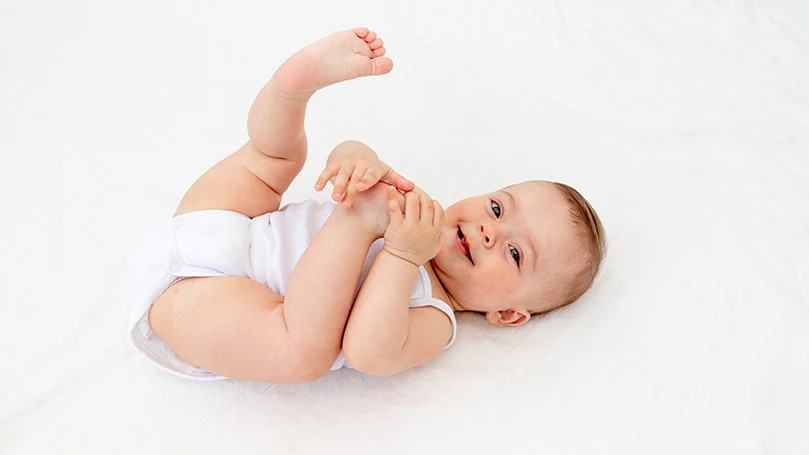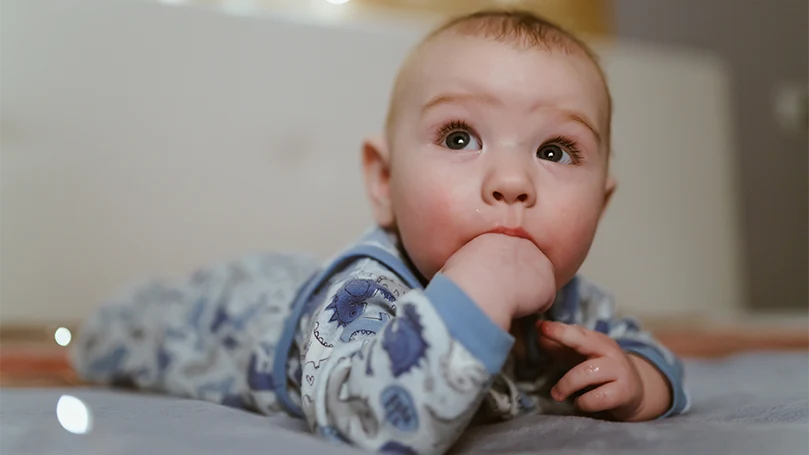What is sleep regression in the first place?
This phase, or more phases, can most simply be described as a sleep disorder. Sleep regression is a completely normal phenomenon for most babies and follows the child's development. This is the period from the first to the sixth week. The first symptom is baby waking up during the night. Skipping an afternoon nap time for no apparent reason is also common. This phase can also occur due to a sudden jump in development, fear of separation, change of rhythm or sleeping space.

Every baby is different. During the first year of a baby's life, development happens at an incredible rate. This is an equally difficult period for babies and parents. While parents are exhausted due to the changed rhythm of sleep, babies are confused by all the changes that happen to them. All these changes that happened all of a sudden affect the quality of your baby's sleep, but there are ways to alleviate the symptoms of regression.
Is it normal for 11-month-olds to experience sleep regression?
It is quite normal for a baby to have regression of sleep during this developmental period. The baby, who will almost turn one year old, is very active and achieves great developmental achievements. That means trying in every way to become independent. For example, she tries to walk by the furniture, gets up without support and tries to take the first steps on her own. She develops fine motor skills, which is why she starts using her hands and fingers to feed herself.

Now she becomes more aware of her needs and expresses her desires. The consequence of this behavior is the first words, understanding simple commands and communicating gestures. Since this period is very exciting for babies, you should not be surprised by her restless sleep or refusal to sleep.
How to recognize sleep regression?
Sleep regressions usually coincide with developmental milestones. For example, it is learning to walk. Whenever a baby adopts a new skill, he or she will want to exercise more and all that affects her sleep. You will notice great irritability, deviation from the routine and a large amount of energy. In addition, there are other signs such as difficulty falling asleep at the usual time, anxiety and refusal to rest.

This means that the child is mature enough to master some basic movements, which strives for self-actualization. This is a period of adaptation and it is very stressful for parents, but there are various methods to ease this transition period for both you and your baby.
Why does my 11-month-old not want to sleep?
The baby at this age is in its infancy for the last month. This means that it is getting closer to toddler period, because you will notice increased mobility and independence. No matter how tired they are, they will always strive for new adventures. This period of their lives will be filled with exploring the new world around them in which they will experiment a lot with toys and touch.
As the baby grows, her curiosity grows. As a result, your child will often refuse to go to bed or wake up more often during the night. To get rid of excess energy, it is best to tire it out by playing before bed. For example, you can run around the house. This will exhaust them and make it easier for them to fall asleep when the time comes.
How to fight 11 month sleep aggression successfully?
Although you will have to deviate from the previously adopted routine, it is not recommended to deviate to the extent that it completely changes the child's sleep pattern since that can disrupt sleep. When using a particular baby sleep training technique, it is important to be consistent and continue your previously started routine. Babies love routine, it gives them security and they know what to do.
If you want to change the way you fall asleep, be patient and ready for the results to take longer. When the baby wakes up during the night, let the atmosphere remain the same, the one in which you sleep. It is enough to be with her and caress her. Give your baby an active day. It is good to spend as much time outside with the baby as possible, so that the baby has various activities during the day.

Ensure your toddler a positive sleep environment
When your baby goes to sleep, take care of the atmosphere in the room. It is necessary to establish a calm atmosphere, which means the absence of loud noise and disturbing stimuli. Although there may not be complete silence in the room, loud noise is undesirable. Many parents use white noise to reduce ambient noise. Reduce amount of natural light as much as possible too.
There must be no negative associations with sleep
Negative sleep associations mainly include rocking the baby before bed, sleeping next to or inside the crib, and holding the baby's hand until he falls asleep. You should break negative sleep associations, because the baby will quickly adopt a bad habit that will be difficult to get rid of.
Get a night light
The night lights provide a light in the room that will not disturb the baby's sleep and which can be comforting in case of waking up. In that case, there will be no major awakening. The night lights also have additional features such as soothing music and projections that automatically calm the baby and help him fall asleep faster.

Try training sleep with your toddler
The goal of sleep training is to get your child used to falling asleep on their own without crying and addressing you. Once a child adopts a positive pattern of behavior, he will only be able to go back to sleep and wake up during the night. The characteristics of the training are keeping a bedtime routine, providing support to the child but not rewarding crying, a clear attitude about the baby staying in bed.
Reschedule night weaning
To gradually eliminate nighttime breastfeeding, it is important to take a few key steps. First of all, make sure that the baby eats enough before going to bed, but avoid solid foods in the evening until the baby's digestive system matures. Also, take care of the conditions in the room where you sleep. For example, it is necessary to establish the ideal room temperature, minimize interference by turning off the light, close the door and eliminate loud noise. Give your baby enough water before bed.

Stick to sleep schedules regularly
A baby can become very nervous and exhausted if he refuses to sleep during the day. So don't insist too much on a regular schedule, but try to stick to it. For example, if your child becomes too excited, try to introduce a new relaxing sleep routine instead of changing your sleep schedule.
Watch for “wake windows”
One of the successful tricks is to keep the baby awake to get tired, but not too much. This is one way to find out how awake your child is between sleeping. In order for your baby to have a healthy sleep, make sure that the shortest wake window always goes before the morning nap while the longest wake window goes before the nighttime sleep.

Let your toddler play during the day as much as possible
Babies enjoy being in the fresh air just as much as humans. Spending time in the fresh air is very important and important for the proper and healthy psycho-physical development of children. Our homes are so well insulated that not enough fresh air and daylight can enter, which has a bad effect on a child's sleep.
Spend time outside
Fresh air and sun exposure help the child recognize the difference between day and night. If you plan activities that involve spending a large amount of energy, your child will certainly sleep through the night and will not wake up. He will also go to bed earlier. Follow the signs of drowsiness and try to put her to sleep when you notice them.

Stay flexible
When this period comes, you must do your best to adapt to the changes that have taken place in the baby. To do this, it is important to stay flexible and be the most supportive of your child. Have a lot of patience and understanding, but not only for the baby but also for your partner.
How long does 11 month sleep regression usually last?
The duration of regression is usually 2 to 4 weeks, sometimes 6 weeks, but it can last only a few days. Sleep regressions are a completely normal developmental phenomenon and usually pass when some of the mentioned tips are applied. However, if you notice that the changes in the rhythm of sleep are significantly pronounced and that none of the methods you have tried help, it is important to consult an expert. Poor sleep quality affects the baby's negative mood, changes in diet and reduced amount of food consumed.

This behavior has a bad effect on its development and therefore it is necessary to monitor the duration of sleep regression. The first year of a baby's life is really challenging, which means that regression occurs several times during that time. That is why you must give your baby a lot of tenderness and understanding for all the changes he is experiencing.
Will 11 month sleep regression stop eventually?
Most regressions take much less time than parents think, usually just a few weeks. Thus, sleep regression stops no later than six weeks. There are various methods, tricks or products that you can use for this purpose. They can significantly reduce the duration of regression as well as alleviate its symptoms. In order for this phase to end on its own, you need to stay consistent with your baby's bedtime routine. It is also necessary to take the necessary steps to prevent the formation of potentially bad habits.
















There are no comments yet
"*" indicates required fields